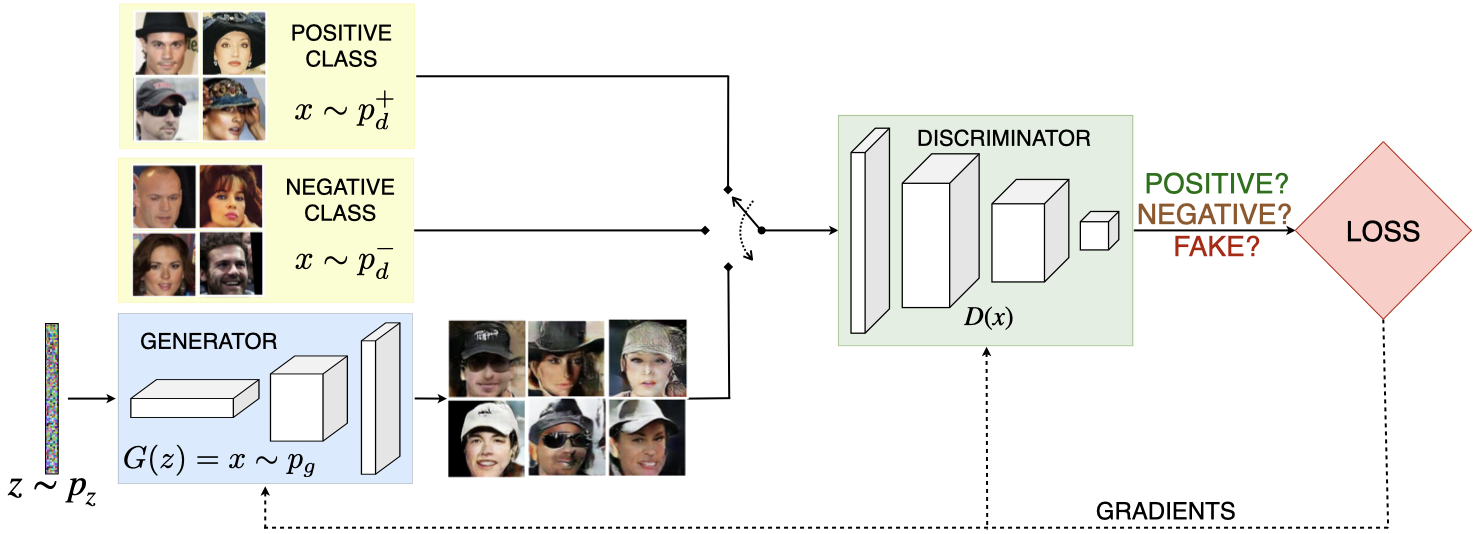Teaching A GAN What Not to Learn
Introduction
This is the Code submission accompanying the NeurIPS 2020 paper, titled "Teaching a GAN What Not to Learn."
This code contained the implementations of baseline SGAN, LSGAN, ACGAN, TACGAN, and CGAN-PD employed in the paper to generate the desired results. All code in written in TensorFlow2.x. Any queries can be directed towards sidartha@iisc.ac.in with [GitHub-RumiGANs] in the subject. In its current state, the code can be used to train new models, while pre-trained models of will be made available shortly.
Rumi-GANs split the training data that is input to the GAN discriminator (D) into positives, which are target images to model, and negatives, which are images from the same dataset, but represent a subset of the distribution to avoid. The generator (G) learns to model only the distribution of the positive samples. Any existing GAN flavor can be reformulated into the Rumi framework --- (i) Split the input data into the desirable positive class and the undesirable negative class; (ii) Reformulate the GAN loss to focus on the positive class disribution. The refomulation of all f-GANs and WGAN is presented in the paper.
The Arxiv version of the paper is available here, while the NeurIPS 2020 pre-proceedings version of the paper is currently available here.
Dependencies and Environment
Dependencies can be installed via anaconda. The RumiGAN_GPU.yml file list the dependencies to setup the GPU system based environment:
GPU accelerated TensorFlow2.0 Environment:
- pip=20.0.2
- python=3.6.10
- cudatoolkit=10.1.243
- cudnn=7.6.5
- pip:
- absl-py==0.9.0
- h5py==2.10.0
- ipython==7.15.0
- ipython-genutils==0.2.0
- matplotlib==3.1.3
- numpy==1.18.1
- scikit-learn==0.22.1
- scipy==1.4.1
- tensorflow-gpu==2.2.0
- tensorboard==2.2.0
- tensorflow-addons
- tensorflow-estimator==2.2.0
- tqdm==4.42.1
If a GPU is unavailable, the CPU only environment can be built with RumiGAN_CPU.yml. This setting is meant to run evaluation code. Training is not advisable.
CPU based TensorFlow2.0 Environment:
- pip=20.0.2
- python=3.6.10
- pip:
- absl-py==0.9.0
- h5py==2.10.0
- ipython==7.15.0
- ipython-genutils==0.2.0
- matplotlib==3.1.3
- numpy==1.18.1
- scikit-learn==0.22.1
- scipy==1.4.1
- tensorboard==2.0.2
- tensorflow-addons==0.6.0
- tensorflow-datasets==3.0.1
- tensorflow-estimator==2.0.1
- tensorflow==2.0.0
- tensorflow-probability==0.8.0
- tqdm==4.42.1
Codes were tested locally on the following system configurations:
*SYSTEM 1: Ubuntu 18.04.4LTS
- GPU: 'NVIDIA GeForce GTX 1080'
- RAM: '32GB'
- CPU: 'Intel Core i7-7820HK @2.9GHz x 8'
- CUDA: '10.2'
- NVIDIA_drivers: '440.82'
*SYSTEM 2: macOS Catalina, Version 10.15.6
- GPU: -
- RAM: '16GB'
- CPU: '8-Core Intel Core i9 @2.3GHz'
- CUDA: -
- NVIDIA_drivers: -
To create the RumiGAN environment, run:
conda env create -f 'RumiGAN_GPU.yml' or conda env create -f 'RumiGAN_CPU.yml' .
Training Data
MNIST, Fashion MNIST and CIFAR-10 are loaded from TensorFlow-Datasets. The CelebA dataset (1.2GB) can be downloaded by running the following code (requires wget dependency):
python download_celeba.py
Alternatively you can manually download the img_align_celeba folder and the list_attr_celeba.csv file, and save them at RumiGANs/data/CelebA/.
Training
The code provides training procedure for baseline Standard GAN^1, LSGAN^2, WGAN^3, WGAN-GP^4, and each of their corresponding Rumi variants. Additionally, ported implementations of auxiliary classifier GAN (ACGAN^5), Twin ACGAN^6 and conditional GAN with projection discriminator (CGAN-PD^7) are included.
- The fastest was to train a model is by running the bash files in
RumiGANs/bash_files/train/. The train the Model for a given test case: Code to train eachFigure X Subfig (y)is present in these files. Uncomment the desired command to train for the associated testcase. For example, to generate images from Rumi-LSGAN on CelebA with class imbalance, Figure 4(i), uncommentCode for Figure 4.iin thetrain_RumiGAN.shfile in the above folder and run
bash bash_files/train/train_RumiGAN.sh
-
Aternatively, you can train any model of your choice by running
gan_main.pywith custom flags and modifiers. The list of flags and their defauly values are are defined ingan_main.py. -
Training on Colab: This code is capable of training models on Google Colab (although it is not optimized for this). For those familiar with the approach, this repository could be cloned to your google drive and steps (1) or (2) could be used for training. CelebA must be downloaded to you current instance on Colab as reading data from GoogleDrive currently causes a Timeout error. Setting the flags
--colab_data 1,--latex_plot_flag 0, and--pbar_flag 0is advisable. Thecolab_dataflag modifies CelebA data-handling code to read data from the local folder, rather thanRumiGANs/data/CelebA/. Thelatex_plot_flagflag removes code dependency on latex for plot labels, since the Colab isntance does not native include this. (Alternatively, you could install texlive_full in your colab instance). Lastly, turning off thepbar_flagwas found to prevent the browser from eating too much RAM when training the model. The .ipynb file for training on Colab will be included shortly.
Reference
If you found this code useful, please consider citing our work:
@misc{asokan2020teaching,
title={Teaching a GAN What Not to Learn},
author={Siddarth Asokan and Chandra Sekhar Seelamantula},
year={2020},
eprint={2010.15639},
archivePrefix={arXiv},
primaryClass={stat.ML}
}
The NeurIPS version of the paper is cirrently available in the pre-proceedings
License
The license is committed to the repository in the project folder as LICENSE.txt.
Please see the LICENSE.txt file for full informations.
Siddarth Asokan
**Robert Bosch Centre for Cyber Physical Systems **
Indian Institute of Science
**Bangalore, India **
Email: siddartha@iisc.ac.in
